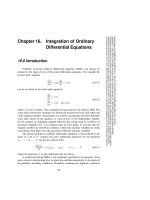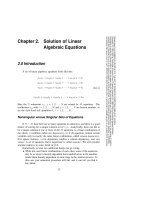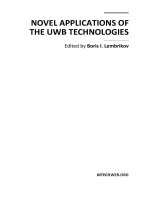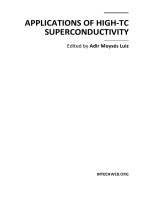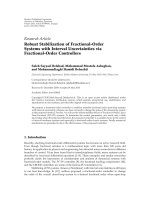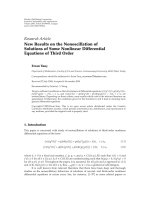Nonlinear oscillations of third order systems. Part 1 Autonomous systems
Bạn đang xem bản rút gọn của tài liệu. Xem và tải ngay bản đầy đủ của tài liệu tại đây (2.99 MB, 9 trang )
Journal o f Technical Physics, 20, 4, S it -519 , 1979.
Potlsck A cadem y o f Sciences. Institute o f Fundamental T echnological Rtxearch, W arszawa.
NONLINEAR OSCILLATIONS OF THIRD ORDER SYSTEMS
PART I. AUTONOM OUS SYSTEM S
NGUYEN V A N D A O (H A N OI)
Introduction
A lot of mechanical and physical problems lead to the study of oscillations in the system
described by the differential equation of the third order:
(0.1) J t +ax+bx + cx = ef(x, X, X, r),
where a, b, c are real constants and the function f(x, x9 3c, t) can be expanded in the form:
H
(0.2) f(x,x,x,t)~ JT elnv,f n(x, x,x).
-N
It is supposed that the characteristic equation:
(0.3) A3 + ứA2-f bX + c = 0
has a pair of cither complex or imaginary roots. We have the following definitions:
1. I f the cha racte ristic Eq . (0.3 ) has a n egative roo t an d a p a ir o f com plex ro ots w ith
a negative real part: Ằi = — f, Ằ2 = — *7 + /í2, Ằ3 = —TỊ-iíỉ, then we have the non-
critical case.
2. If the characteristic equation has a negative root and a pair of imaginary roots
A1 = — f , A2 = iQ> A3 = — /Í3 , then we have the c r it ic a l case. Ia a d d itio n , i f V ^ p ỉqũ ,
where /7, q are integers and V is the exciting frequency, then we have the critical resonant
case.
The non-critical case has been investigated in many publications (see, for example
[1-6])» but the critical case has not, to the author’s knowledge, been examined hitherto.
In this work we study systematically the different kinds of nonlinear oscillations: free
oscillation, self-excited oscillation, forced oscillation and the parametric one of the third
order system in the critical case, by means of the asymptotic method [8, 9].
In the critical case, in the generated system (fi = 0), there exists the harmonic oscillation
depending on two arbitrary parameters a and Y>:
X = acos(Q t + y).
Wc shall not look for the general solution of Eq. (0.1) depending on three arbitrary
constants, instead wc shall construct a family of two-parameters particular solutions,
which has a strong stability property. It attracts all solutions close to itself of Eq. (0.1).
7 I. T cch a. Phys. 4/79
512
Nguyen Van Dao
The ap p ro x im a te a sym p to tic m ethod is convenie n t fo r the in v e stig a tio n o f stationary
o scillatio n s a n d th e ir sta bility.
T o assess the v a lid it y o f the theo ry, a series o f experim e n ts on the a n a log com p u ter
have been m ade. T h e th e ore tical results show a g o o d agreement w ith the e xperim e nta l
ones.
T h is c h a p t e r co n s is ts o f five S ections. In the first S ectio n the tw o -p a ram ete rs solu tio n
o f Eq. (1 .1 ) is c o n stru cted b y m eans o f the K r u lo v -B o g o liu b o v a s ym p totic m ethod. I n
the seco n d S ectio n , the D u ffin g case R - -Ộ X3 is consid e red. It has tu rne d out that the
a m p litude o f free o sc illa t ion increases i f ậ > 0 , a n d d ecreases i f /? < 0 . Th e th ir d S e ctio n
is d evoted to the stu d y o f the self-excited oscilla tio n in the third -o r d e r system , w hen th e
functio n R is o f th e fo r m R = (1 - x 2)x. It has been fo u n d th a t in the system in v estigate d ,'
there e x ists a stable lim it cycle. Th e influence o f the C o u lo m b fr ic t io n a n d the turb ule n t
one on the self-excited o scilla tio n in the third o rde r system , is exam in ed in Sects. 4 an d 5.
It has been p ro ved th a t the a m p litude o f the se lf-e xcited o scilla tio n d ecreases as these
fric tio n s increase . In a d d itio n , the self-excited o scillatio n c a n d isap e a r u n d e r the a c tio n
o f a stro n g C o u lom b fric tio n .
1. Construction of Two-Parameters Solution. Stability
Let u s c o n sid er the fo llow ing n o n lin e ar d iffe rentia l e q u a tio n o f the t h ir d o rde r:
(11) 'i' + ỉ'x + ũ 2x + ỉũ 2x = eR(x, X, x),
where f , ÍÌ are consta n t s, £ is a s m a ll p aram eters a n d R is a n o n lin e a r fu n ctio n o f X, X, X.
W e sha ll fin d a so lu tio n o f E q. 1.1 in the fo rm :
(1.2 ) X = acosẹ>+ eUịia, 9? ) + e2u2(a, <p)+
cp = íĩt + yĩ' H ere a an d y are the fu n ctio n s satisfyin g the fo llo w in g d ifferentia l e q u a tio n s:
(1.3 )
S u b s titu tin g the expressio n s (1.2 ), (1.3) into (1 .1) and c o m p a rin g the coefficients o f e
w ith e qu a l degre es, w e h a v e :
(1 .4) 2í2(QaBị —ỈAỵịsinqĩ—líĩiỉa B i + í2 ^ i)c o s 9 ? +
(1.5) R0 = i?(acosẹ>,-í2 asin<p,-í22đcos7>)‘
T o fin d the u n k n o w n fu n ctions A l , B i, Uị fro m (1 .4 ), w c first e xpand Rq in th e F o u rie r
series:
Nonlinear oscillations o f third order systems. Part I
513
00
(1.6 ) Ko = £ [g ,(a ) c o s « 9>+/i„(a)sinM (p],
/7=0
£0(0) = J- f Rodv - <^o>>
0
2n
g„(<j) - I R0cosn<pd<p = 2 < /ỉ0c0SH95>,
71 0
2n
/?„(ớ) = — f R0sinn(pd(p — 2 (R0sinnọĩ>,
71 0
in w hich /J = 1,2, and < ) is the averaged operator on time.
The function ;/x is also found in the series:
(1.7) ií, = ^ [M1B1(a)cosw ^ 4 i>im(«)sin;/i<iO,
Ml
with the condition that it does not contain tbc term s having a zero denominator.
Dy substitutin g (1.6 ), (1.7) into (1.4 ) \vc o b tain :
(1.8) 0 * 2 ( 1 - m 2) [(Ệuim+mQvln)cosm<p+(ỉvim-m íìu lm)smm<p]-
m
00
—2 ũ (ữA l + ỉaBị)cos<p+ĩũ(a^B1 -Ệ A^sinip = ^ [g„(a)co&n<p+hn(a)smn<p].
«» 0
B y c o m pa rin g the s in 9?, COS9? terms in (1.8 ) w e have:
iQịŨA. + aỆB,) = - £ t(a),
2 i3 (-^ 1+fli251) = A,(a).
H ence one obta in s:
A < \ _ £ M ứ) + % i ( a) _ í</? o sin ọ 7 > + i3 < ^ 0cos(p>
( ) lW 2£(f2+ £ 2) a tf’+ fl2)
» _ £ < -RoS in < p > -£<*oC O S 9>>
lV ' 2ứ a ( í J + í 3 2) i 2a ( f J + £ J)
T h e c o m p a riso n o f the oth er h a rm o n ics yie ld s:
i 2 2 ( l -W 1 2) ( f w , B + w i 2 & lln ) = g m( a ) ,
£ 2(1 - m 2) (-rní2uỉm + Ệvlm) = /fm(a ), m # 1.
H e n ce it fo llow s:
ỉ g m ( à ) - m í ì h m {a)
Í22(l —m2) (ỉ2+m2ữ2) ’
ih m(à)+ m ữ gm(a)
tfJ(l —ma) ( |J+mĩÃ2)
514
Nguyett Van Dao
Thus, in the first approximation we have:
(1 .1 1 ) X = aco s(.Q /H-yO ,
where a aud xp arc the solution of the equations:
d a _ í < / ?0 sinẹ>>-l í?<y?0 Cos <p>
( 1. 12)
dtp _ Q(R0sin(py — Ệ(R0cos(py
d t e Q a ( Ệ 2 + Q 2)
T h e refinement of the first a p p roxim a tio n is :
(I n ) r = /7rvYc(.Q/+ ,,,) + V { h m-inQh„)cosm(Qt+ỳ) + (Ậli,„+mQgm)únin[Qt+'
Z j "
ú 2(l —/«*)(£* +/»*£?*)
#/* =» 0
m*\
T h e c a lcu lation s o f higher ap p roxim a tio n s present n o difficultie s, but are rath er 1.
and «irc n o t re p rod u ced here.
W e can w rite the first equation o f the system (1.12 ) as:
(1.14) 6 0 (a ).
dt
Obviously, the stability condition of the stationary solution a = a0y &(ơ0) = 0
(1.14) is of the form:
(1.15) 0 '(ao) < 0.
2. The Duffing Case
L e t u s c o n sid e r the case i? (x , X, X) = —ậ x 3. N o w , E q. (1 .1) has the fo rm :
(2 .1) X + Ệx+ ữ2i + Ỉ Q 2x+ ePx* = 0 .
I n this case w e have:
(2.2) R0 = —/?ứ3cos3<p = — Ỵ ứ3 (3 cos 9?+cos 3ẹ?),
a n d th e refore
g t( a ) = - J 0 a 3 , h ^ a ) = 0 ,
(2.3 )
w \ _ w JJ , x 3Ệpa2
M a) ~ 8 + • Bl{a) - + ■
E q u a tio n s (1 .12 ) are o f the form :
(2 4Ì ^ = _L/?*/73 _ £ /?*ỵj2 ứ*
dt 2 dt ~ 2 Q P ' " 4 (f a + f l a) ■
Nonlinear oscillations o f third order systems. Part I
515
B y in tegrating Eqs. (2.4) w ith the in itia l v a lues (/0 , a0) we o b tain :
(2 .5 )
a2 =
-
CL =
a - / ? * ( / - / 0) al
Í ft*
V = V o -yfí- l n l - ^ ơ - / o ) .
H e n ce it follo w s that (see F ig . 1):
1. I f /? > 0 then the am plitude o f the o scilla tio n increases fo r t > f0 fro m a = a0
to a ~+ 0 0 .
2. I f /5 < 0 then the am plitud e o f oscilla tio n decreases from a = (ỈQ to a 0.
T h us, 1he n o n linear term has a great in fluence on the fo rm o f the response curv e o f
free o scilla tio n . T o c h eck the v a lid ity o f the th e o retical analysis, an a n a lo g -com p u tcr
analysis has been carried out. T ile exam ple s o f the w ave fon n s obtained o n the analo £ -
computer for E q . (2.1), with the param eters Ệ = 10, i2 = 1, are shown in Fig. 2. In this
figu re, the first w ave (a) shows the case p - 0 , the second (b)—(ỉ *-= - JO, and the third
(c)—ỊÌ = 10. T h e figure conta in s all types o f osc illa tio ns that arc predicted by the th eory.
a „
0.3
0.2
Fig . 1.
F ig. 2.
3. Self-Excited Oscillation
In this S e c tio n we s h a ll study the V a n der P o l case:
(3.1 )
R(xt X, x) = (1 —x2)x.
I t is easy to see th at:
(R0sin 9?) = —
< /? o C o s < p > = 0 ,
(3.2)
516
(3 .2 )
Nguyen Van Dao
gn = 0, 'in, hm = 0 , m # 1 , 3 ,
Q
Hị = —aQ
T h e refo re, the equa tio n s o f the first a p p roxim atio n are:
(3.3) X = flcos<p,
(3.4)
da
h ĩ ■* 20FTQ2)
4 - t ).
E q u a tion (3 .4) has a statio n ary solutio n ứ0 = 2. T h e sta b ility co n d ition (1.15) for this
so lutio n is satisfied.
F ig . 3.
T h e re finem ent o f the first a p p ro xim atio n is o f the fo rm :
(3.5) X = 2cosỢ2/ + y0)+ 4 (g2 + 9Q1) [3 cos 3(^r + Vo) - -jjSin3(flf + Vo) j .
T o v e rify th e th eoretical resu lts, the o rig in a l Eq . (1.1 ) w ith R fro m (3.1 ), is m odelle d
o n the an a lo g -com p u ter M E D A 4 1 -T C fo r the case ỉ = Q = 1, e = 0 .1 . T h e oscillacio n
d ia g ram s are presented in F ig . 3 : displacem ent-tim e an d F ig . 4 : phase pictu re . T h e
e xperim e nta l re sults agree w ell w ith the theoretic al ones.
“x
2
Nonlinear oscillations o f third order systems. Part Ị
517
4. Influence of Coulomb Friction on Sclf-Exdtcd Oscillation
In th is Section the influence o f the C o u lom b fric tio n
(4.1) Rf = /?0s ig n x \ h0 > 0
on the self-e xcited Van der Pol o sc illatio n is exam ined. In this case the m o tio n equatio n
is o f the form :
(4 .2)
‘x +ỆX + Q2X + ỆQ2x+ £ (x 2- l ) x - f £/j0sign.v = 0
T o fin d the solu tio n o f Eq. (4.2), we use the theory represented in Sect. 1. Ta k ing in to
account
<sinọ? sig n s in ẹ?) = 2/tt, < c o s <p sig n sin <p> = 0 ,
we have in the firs t a p p roxim a tio n :
(4 .3) A* = a cos <p,
(4.4)
da
dt
d(p
di
CỆ
ỉ 2+ n 2
ị ( ' i i v
= Q
eQ
___________
. 1 - - - 1
2(Ỉ2 + Q2) V 4
F r o m E q. (4 .4), it is seen that by the a p p e a ran c e o f the Co u lo m b fric tio n , the o rig in
.V = X = 0 is not still an e q u ilib riu m o f the syste m considered. T o c le ar up the in fluence
o f the C o u lo m b fric tio n on the self-excited o scilla tio n , w e investigate the statio n ary state
w ith the am plitud e determ ined b y the equation
(4 .5)
A( 1 - A 2) = /4 = - y > .0.
T h is equation can be solved g ra p h ica lly b y c o n sid e rin g the poin t o f in tersectio n o f
the cu b ic curv e y t = A(i-A2) and the starig ht lin e y 2 = Iho/jtii. F ig u r e 5 leads to the
follow in g con c lu sio ns:
1. W h e n h0 = 0 in the system consid ered, th ere exist two stationary states corresp o n d
ing to A ị = 0 (unsta b le) and A 2 = 1 (self-excited o s cilla tio n ).
2. W ith in cre asin g h0 (0 < ỌìqItcQ) < 1 / 3 ^ 3 ) , A l in creases and A2 decreases.
518
Nguyen Van Dao
E q u a tio n (4.4) can be w ritten in th e fo r m :
cỉ/Ấ £ Ẽ
(4-6) ^ r = - 2(ỉ * + Q2) (A ~A^ (A ~ Ẩĩ) = e0(A),
w here A3 < A ì < A2y (A3 < 0 ). It is easy to see th at 0 'C ^ i) > 0> <P'(A2) <
the refo re the statio n ary state c o rre s p o n d in g to A l is unstable a n d the state A 2 ii
(se lf-e xcited o scilla tio n ). O bviously , in th is cas e the C o u lo m b fric tio n decreases the
tude o f the self-excited o scillatio n .
3. W ith h igh valu e s o f h0(h0 > (QrtỊ3 j / 3 )) the self-e xcited o sc illa tio n disap pea
T h u s, depend in g on its values, the C o u lo m b frictio n c a n either decrease o r exti
the self-e xcited oscilla tio n .
5. Influence of TarbuleDt Friction on Self-Excited Oscillation
N o w , we go o ver to the study o f the o s c illa t io n d escrib e d b y the e q u a tio n :
(5.1 ) x + Ệ x + & x + Ệữ2x + e (x 2- l ) i + e h 2x2signx = 0 ,
w h ere in the Jast term ch aracterizes the t u rbu le n t frictio n . B y m a k ing use o f the m
pre sen ted in P ar. 1 we obtain the fo llo w in g equ a tio n s o f the first a p p ro x im atio n :
* = acoscp,
d A EỆ
~ dt =
(5 .2 )
d(p
dt
= Q
2 (Ệ2 + Q2)
e Q
A{\
A * ) - y - Q h 2A*
]•
A =
2(ề2 + Q2)
Considering in the first quadrant of the plane (y, A) the points of intersection o
c u b ic c u rve y x = A ( \-A2) and the p a ra b o la )*2 = (ỉ6/3n)íĩlĩ2A2 (F ig . 6) one can
that:
F i g . 6 .
1. I n the system described by E q . (5.1 ) there a lw a y s exists the u n sta b le station*
state A = 0.
2. W h e n in cre a sin g the coefficient h2 fro m z e ro, the a m p litude o f self-excited o s c illa ti
decreases. I n con trast to the case w ith the C o u lo m b fric tio n , the self-excited o scilla ti
here is n o t extin guished com pletely.
Nonlinear oscillations o f third order systems. Part I
519
References
1. z . O s in ski, Vibra tions o f an one-degree o ffre edom system w ith non -linear inte rnal fric tio n and relaxa tio n ,
Proc. Inter. Conf. on N on-Linear Oscillations, T. Ill, K iev 1963.
2. z. Osinski, G. B o y a d uev, The vibra tio ns o f the system with iion-linear friction and relaxation with slowly
variable coefficients, Proc. 4th C onf. on N on-L inear O scillations, Prague 1967.
3. H. R. S rir a n g a r a ja n , p. Srin iv asan, Application o f ultra spherical polynomials to forced oscillations
o f a third order non-linear system, J. Sound V ibr, 36, 4, 1974.
4. H. R. S rir a n g ara ja n , p. Sriniv asan , Ultra spherical polynom ials approach to the study o f third-order
non-linear system s, J. Sound V ibr., 40, 2, 1975.
5. A. T o n d l, Notes on the solution o f forced oscillations o f a third-order non-linear systcm> J. Sound Vibr.,
37, 2, 1974.
6. A. T o n d l, Additional note on a third-order system, J. Sound Vibr., 47, 1, 1976.
7. z. Osinski, N guyen V an Dao, Parametric oscillation o f an uniform beam in a rheological model, Proc.
2nd N ational Conf. on M echanics, H anoi 1977.
8. N . N. B o g o l iu b o v , Yu. a . M i tro p o l s k y , Asym ptotic m ethods in the theory o f non-linear oscillations,
Moscow, 1963.
9. N guyen V an D ao, Fundamental methods o f non-linear oscillations, Hanoi 1969.
]0. H . K aud e rer, Nichtlineare Mecfiartik, Berlin 1958.
Streszczenie
NIELINIOWE DRGANIA U K LAD 0W TRZECIEGO RZẸDƯ
CZẸỐC I. ƯKLADY AUTONOM ICZNE
Rozpatrzono drgania nieliniowego ukladu opisanego rów naniera rózniczkowyra zwyczajnym trzecicgo
rzẹdu. Przyjẹto, ze u klad podstawow y ma rownanie charakterystyczne o jednym rzeczywistym i dvvổch
urojonych pierw iastkach.
w niniejszej, picrwszcj czẹáci pracy zbadano digania ukladu autonomicznego. R ozpatrzono nielinio-
w oSỎ funkeji restytucyjnej w postaci funkeji Duffinga, charakterystyki tlumienia w postaci tarcia Coulomba
i tarcia turbulentnego. Zbadano drgania samowzbudne przy rốznych rodzajach tarcia.
p e 3 K> M c
H E JIH H E H H L IE KO JIEBA H R H C H C T H M T P E T b E rO nOPflJXKA
M A C Tb I. A B T O H O M H B IE C H C T E M L I
PaCC M aT pH BaiO Tai KOJieỐaHHfl He/IHHCHHOH CRCTCMbI OHHCyCMOH c DOMOLUbJO OỔbCKHOBCHHOrO A H Ộ Ộ e-
peHUHajibH oro ypoBHCHHH TpeT bero n o p a n n a . n p c A n o jia r a c T o r, *rro xapaKTCpHCTH^ecKoc ypaBHCHHe
HMeeT OAHH AeftCTBHTCJTbHWA H JJB a MHHMbIX KOpHfl. 3TO T C J iynail H23BAH KpHTJTOCKHM. B HaCTOHmeỒ,
nepBoft uacm paốOTbi HCCJieAyioTCH KOJie6aHHH aBTOHOMHOỈí CHCTCMbi. PaccMaTpHBaioTca HCJiHHeữH0CTb
ộyHKUHH BOCraHOBJieHHH B BJtfle ộyHKUHH ilK>4>4>HHa H XapaKTCpHCTHKH ACMnỘHpOBaHHH THUa TpCHHH
K yjio H a H T yp6yjieHTH oro TpcHKH. HccjieAyioTCH caM 0B03ổy>KtuicMi>ic KOiieổaHHH ỊỤIH pa3JDFiHbix THnoB
TpeHHH.
Received October 17, 1978.

